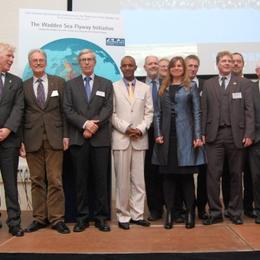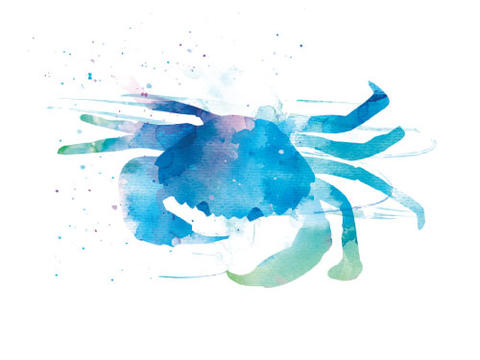






Biodiversity
The Wadden Sea possesses a complex matrix of habitats across environmental gradients of depth and salinity, height and dryness, exposure to hydrodynamics and winds, and substrates modified by organisms. These habitats occur in dynamic sequences in a highly repetitive pattern due to the long chain of islands and shoals, tidal basins and estuaries, and together accommodate a high diversity of aquatic and terrestrial species.
This forms a habitat for about 2,700 species of marine origin and at least 5,100 semi-terrestrial and terrestrial species, mostly the flora and fauna of salt marshes and dunes on the islands (Table 1).
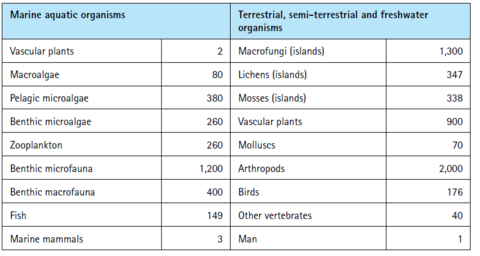
Table1: Overview of species richness in the Wadden Sea. In some groups, numbers have been estimated. Due to taxonomic uncertainties, not all species complexes have been analysed, and in terrestrial environments surveys on small soil fauna are incomplete. Rare visitors are left out.
Various unicellular groups and small metazoans such as terrestrial nematodes have not been included in the surveys. Including these, we estimate that the Wadden Sea area is populated by about 10,000 taxa, not including bacteria and archaea. Of the taxa recorded, phototrophic plants comprise about 2,300 species, macrofungi 1,300 species and animals 4,200 species. With this impressive species richness the Wadden Sea helps to arrest the loss of coastal biodiversity in temperate coastal zones.
Presumably, a crucial factor for the high richness of species is the repetitive sequences of dynamic habitats on a large scale. This is likely to reduce the risk of extinction.
- Salt marsh species
-
An incredible number of small arthropod species (mainly insects and spiders) live in the salt marshes,. The main primary producers, the vascular plants, comprise only 45 species. Directly feeding on these plants are 6 species of waterfowl and 400 species of insects. Another 500 species have been found to feed on dead plant material, algae and fungi. Predaceous arthropods comprise 245 species and parasites 250 species. To this spectrum we may add about 100 species of birds feeding and resting in salt marshes. The sum of all these species is almost 1,600. To these terrestrial organisms some 500 species of aquatic, mostly marine invertebrates of the meiofauna, have to be added. Again, considering unicellular organisms not included in the surveys, the grand total is about 2,300 taxa, which may dwell in salt marshes of the Wadden Sea. This compares well with the species richness encountered in European temperate forests.
- Fish
-
Of the 140-plus species of fish recorded in the Wadden Sea, 20 spend their entire life in the tidal area. Plaice (Pleuronectes platessa) and sole (Solea solea) spawn in the North Sea and their pelagic eggs and larvae drift into the tidal area, metamorphose and settle on the mud flats. There they benefit from ample food and warm temperatures . They leave the Wadden Sea as juveniles before their first winter. Also, juveniles of herring and sprat occur in big shoals, particularly at night. Several diadromous species spawn in the rivers and merely pass through the Wadden Sea. Whiting and cod have open sea nurseries, but in late summer and autumn of some years, juveniles make incursions into the Wadden Sea with dramatic effects on shrimp and small fish on which they prey.
- Migratory and breeding birds
-
For coastal birds, the Wadden Sea is not only attractive because of the high availability of food. Some of the islands and high sands lack mammalian predators and human disturbance. Almost one million ground-breeding birds belonging to 31 species use these sites. For Eurasian spoonbill, avocet, gull-billed tern and sandwich tern, more than 25% of the European populations breed in the Wadden Sea region. For 43 species, the Wadden Sea supports more than 1% of the flyway population, which is the criterion of the Ramsar Convention for identifying wetlands of international importance.
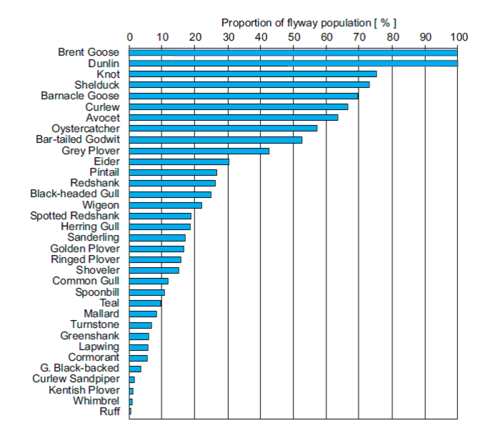
Figure: Maximum estimated numbers of migratory birds between 1992-2000 given as proportion of flyway populations for the entire Wadden Sea
Of these, four breed in the Wadden Sea, 15 only visit during their seasonal migrations, and 24 do both. Almost the entire population of dark-bellied brent goose (Branta b. bernicla) and the entire European and West-Russian population of dunlin (Calidris alpina) use the Wadden Sea during periods of the annual cycle (Figure above). An additional seven species are present with more than 50%, and a further 14 species consisting of more than 10% of their flyway populations. In absolute numbers, it is estimated that dunlin reaches a seasonal maximum of 1.4 million, oystercatcher 582,000, black-headed gull 499,000, red knot 339,000 and wigeon 333,000. In late summer, almost all shelducks of Northern and Western Europe concentrate, with about 200,000 birds moulting in the least disturbed areas of the Wadden Sea. Many birds use the Wadden Sea only briefly, others do so for several months and use the area to gain enough energy for further migration. Other species spend the whole winter in the area. Hence, the numbers actually using the area (10 to 12 million) are much higher than the total numbers present at any one time. Nonetheless, the Wadden Sea is one of the most spectacular sites for coastal birds in the world.
- Marine mammals
-
Indigenous species of marine mammals in the Wadden Sea are the common seal (Phoca vitulina), grey seal (Halichoerus grypus) and harbour porpoise (Phocoena phocoena). The Wadden Sea now sustains approximately 20% of the Northeast-Atlantic subspecies of common seal. Archaeological findings suggest that grey seals were the dominant seal species until medieval times and then vanished entirely. The cause was most probably the ease of hunting during whelping on the upper beaches. Recently grey seals have also started a comeback. During the moulting season, 20,250 common seals and 1,900 grey seals resting on sand bars have been counted from the air in 2008. In the northern Wadden Sea, female harbour porpoise with offspring are observed with a density of 1-2 individuals per km2.
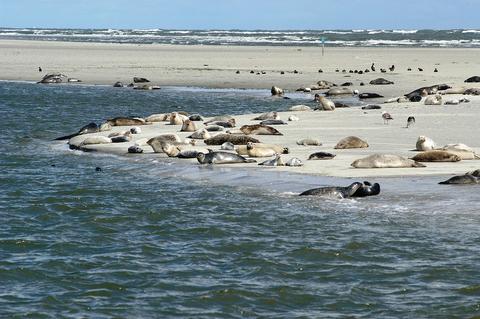
Seals (Photo Klaas Kreuijer)Link Harbour seal counts 2013 (link annual updates)
